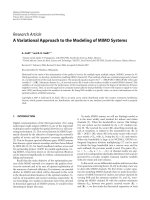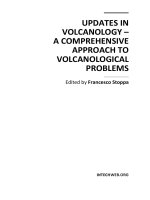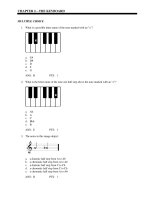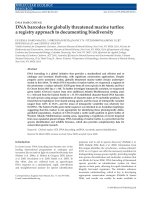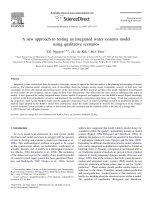Weiss multiagent systems a modern approach to distributed artificial intelligence
Bạn đang xem bản rút gọn của tài liệu. Xem và tải ngay bản đầy đủ của tài liệu tại đây (4.63 MB, 585 trang )
Page iii
Multiagent Systems
A Modern Approach to Distributed Modern Approach to Artificial Intelligence
edited by Gerhard Weiss
The MIT Press
Cambridge, Massachusetts
London, England
Page iv
©1999 Massachusetts Institute of Technology
All rights reserved. No part of the book may be reproduced in any form by any
electronic or mechanical means (including photocopying, recording, or information
storage and retrieval) without permission in writing from the publisher.
This book was set in Computer Modern by Gerhard Weiss.
Printed and bound in the United States of America.
Library of Congress Cataloging-in-Publication Data
Multiagent systems: a modern approach to distributed artificial intelligence / edited
by Gerhard Weiss
p. cm.
Includes bibliographical references and index.
ISBN 0-262-23203-0 (hardcover: alk. paper)
1. Intelligent agents (Computer software) 2. Distributed artificial intelligence.
I. Weiss, Gerhard, 1962- .
QA76.76.I58M85 1999
006.3—dc21
98-49797
CIP
Page v
CONTENTS IN BRIEF
Contributing Authors
xix
Preface
xxi
Prologue
1
Part I: Basic Themes
1
Intelligent Agents
27
Michael Wooldridge
2
Multiagent Systems and Societies of Agents
79
Michael N. Huhns and Larry M. Stephens
3
Distributed Problem Solving and Planning
121
Edmund H. Durfee
4
Search Algorithms for Agents
Makoto Yokoo and Toru Ishida
165
5
Distributed Rational Decision Making
201
Thomas W. Sandholm
6
Learning in Multiagent Systems
259
Sandip Sen and Gerhard Weiss
7
Computational Organization Theory
299
Kathleen M. Carley and Les Gasser
8
Formal Methods in DAI: Logic-Based Representation and Reasoning
331
Munindar P. Singh, Anand S. Rao, and Michael P. Georgeff
9
Industrial and Practical Applications of DAIH.
377
Van Dyke Parunak
Page vi
Part II: Related Themes
10
Groupware and Computer Supported Cooperative Work
125
Clarence Ellis and Jacques Wainer
11
Distributed Models for Decision Support
459
Jose Cuena and Sascha Ossowski
12
Concurrent Programming for DAI
Gul A. Agha and Nadeem Jamali
505
13
Distributed Control Algorithms for AI
539
Geraint Tel
Glossary
583
Subject Index
609
Page vii
CONTENTS IN DETAIL
Contributing Authors
xix
Preface
xxi
Purpose, Features, Readership, How to Use This Book, One Final Word,
Acknowledgments
Prologue
1
Multiagent Systems and Distributed Artificial Intelligence
1
Intelligent Agents that Interact
2
Challenging Issues
5
Applications
6
Rationales for Multiagent Systems
8
A Guide to This Book
9
The Chapters
9
The Exercises
19
The Glossary
19
A Few Pointers to Further Readings
20
References
21
Part I: Basic Themes
1
Intelligent Agents
27
Michael Wooldridge
1.1 Introduction
27
1.2 What Are Agents?
28
1.2.1 Examples of Agents
31
1.2.2 Intelligent Agents
32
1.2.3 Agents and Objects
34
1.2.4 Agents and Expert Systems
36
Page viii
1.3 Abstract Architectures for Intelligent Agents
36
1.3.1 Purely Reactive Agents
38
1.3.2 Perception
38
1.3.3 Agents with State
40
1.4 Concrete Architectures for Intelligent Agents
42
1.4.1 Logic-based Architectures
42
1.4.2 Reactive Architectures
48
1.4.3 Belief-Desire-Intention Architectures
54
1.4.4 Layered Architectures
61
1.5 Agent Programming Languages
66
1.5.1 Agent-Oriented Programming
67
1.5.2 Concurrent METATEM
69
1.6 Conclusions
70
1.7 Exercises
71
1.8 References
73
2
Multiagent Systems and Societies of Agents
79
Michael N. Huhns and Larry M. Stephens
2.1 Introduction
79
2.1.1 Motivations
80
2.1.2 Characteristics of Multiagent Environments
81
2.2 Agent Communications
83
2.2.1 Coordination
83
2.2.2 Dimensions of Meaning
84
2.2.3 Message Types
85
2.2.4 Communication Levels
86
2.2.5 Speech Acts
87
2.2.6 Knowledge Query and Manipulation Language (KQML)
88
2.2.7 Knowledge Interchange Format (KIF)
92
2.2.8 Ontologies
94
2.2.9 Other Communication Protocols
95
2.3 Agent Interaction Protocols
96
2.3.1 Coordination Protocols
97
2.3.2 Cooperation Protocols
99
2.3.3 Contract Net
100
2.3.4 Blackboard Systems
103
2.3.5 Negotiation
104
2.3.6 Multiagent Belief Maintenance
107
2.3.7 Market Mechanisms
109
2.4 Societies of Agents
111
2.5 Conclusions
114
Page ix
2.6 Exercises
114
2.7 References
118
3
Distributed Problem Solving and Planning
121
Edmund H. Durfee
3.1 Introduction
121
3.2 Example Problems
122
3.3 Task Sharing
124
3.3.1 Task Sharing in the Tower of Hanoi (Toll) Problem
125
3.3.2 Task Sharing in Heterogeneous Systems
127
3.3.3 Task Sharing for Distributed Sensor Network Establishment (DSNE)
129
3.3.4 Task Sharing for Interdependent Tasks
130
3.4 Result Sharing
131
3.4.1 Functionally Accurate Cooperation
131
3.4.2 Shared Repositories and Negotiated Search
133
3.4.3 Distributed Constrained Heuristic Search
133
3.4.4 Organizational Structuring
135
3.4.5 Communication Strategies
137
3.4.6 Task Structures
138
3.5 Distributed Planning
139
3.5.1 Centralized Planning for Distributed Plans
139
3.5.2 Distributed Planning for Centralized Plans
140
3.5.3 Distributed Planning for Distributed Plans
141
3.6 Distributed Plan Representations
149
3.7 Distributed Planning and Execution
151
3.7.1 Post-Planning Coordination
151
3.7.2 Pre-Planning Coordination
152
3.7.3 Interleaved Planning, Coordination, and Execution
153
3.7.4 Runtime Plan Coordination Without Communication
156
3.8 Conclusions
157
3.9 Exercises
158
3.10 References
161
4
Search Algorithms for Agents
165
Makoto Yokoo and Toru Ishida
4.1 Introduction
165
4.2 Constraint Satisfaction
168
4.2.1 Definition of a Constraint Satisfaction Problem
168
Page x
4.2.2 Filtering Algorithm
170
4.2.3 Hyper-Resolution-Based Consistency Algorithm
172
4.2.4 Asynchronous Backtracking
173
4.2.5 Asynchronous Weak-Commitment Search
176
4.3 Path-Finding Problem
179
4.3.1 Definition of a Path-Finding Problem
179
4.3.2 Asynchronous Dynamic Programming
181
4.3.3 Learning Real-Time A*
182
4.3.4 Real-Time A*
184
4.3.5 Moving Target Search
185
4.3.6 Real-Time Bidirectional Search
187
4.3.7 Real-Time Multiagent Search
4.4 Two-Player Games
190
191
4.4.1 Formalization of Two-Player Games
191
4.4.2 Minimax Procedure
192
4.4.3 Alpha-Beta Pruning
193
4.5 Conclusions
195
4.6 Exercises
196
4.7 References
197
5
Distributed Rational Decision Making
201
Thomas W. Sandholm
5.1 Introduction
201
5.2 Evaluation Criteria
202
5.2.1 Social Welfare
202
5.2.2 Pareto Efficiency
202
5.2.3 Individual Rationality
203
5.2.4 Stability
203
5.2.5 Computational Efficiency
204
5.2.6 Distribution and Communication Efficiency
204
5.3 Voting
204
5.3.1 Truthful Voters
205
5.3.2 Strategic (Insincere) Voters
207
5.4 Auctions
211
5.4.1 Auction Settings
211
5.4.2 Auction Protocols
212
5.4.3 Efficiency of the Resulting Allocation
213
5.4.4 Revenue Equivalence and Non-Equivalence
214
5.4.5 Bidder Collusion
214
5.4.6 Lying Auctioneer
215
5.4.7 Bidders Lying in Non-Private-Value Auctions
216
5.4.8 Undesirable Private Information Revelation
216
Page xi
5.4.9 Roles of Computation in Auctions
5.5 Bargaining
216
220
5.5.1 Axiomatic Bargaining Theory
220
5.5.2 Strategic Bargaining Theory
221
5.5.3 Computation in Bargaining
223
5.6General Equilibrium Market Mechanisms
224
5.6.1 Properties of General Equilibrium
225
5.6.2 Distributed Search for a General Equilibrium
226
5.6.3 Speculative Strategies in Equilibrium Markets
229
5.7 Contract Nets
233
5.7.1 Task Allocation Negotiation
234
5.7.2 Contingency Contracts and Leveled Commitment Contracts
239
5.8 Coalition Formation
241
5.8.1 Coalition Formation Activity 1: Coalition Structure Generation
242
5.8.2 Coalition Formation Activity 2: Optimization within a Coalition
247
5.8.3 Coalition Formation Activity 3: Payoff Division
247
5.9 Conclusions
251
5.10 Exercises
252
5.11 References
253
6
Learning in Multiagent Systems
259
Sandip Sen and Gerhard Weiss
6.1 Introduction
259
6.2 A General Characterization
260
6.2.1 Principal Categories
261
6.2.2 Differencing Features
262
6.2.3 The Credit-Assignment Problem
264
6.3 Learning and Activity Coordination
266
6.3.1 Reinforcement Learning
266
6.3.2 Isolated, Concurrent Reinforcement Learners
268
6.3.3 Interactive Reinforcement Learning of Coordination
270
6.4 Learning about and from Other Agents
272
6.4.1 Learning Organizational Roles
273
6.4.2 Learning in Market Environments
275
6.4.3 Learning to Exploit an Opponent
278
6.5 Learning and Communication
281
Page xii
6.5.1 Reducing Communication by Learning
283
6.5.2 Improving Learning by Communication
284
6.6 Conclusions
289
6.7 Exercises
292
6.8 References
294
7
Computational Organization Theory
299
Kathleen M. Carley and Les Gasser
7.1 Introduction
299
7.1.1 What Is an Organization?
300
7.1.2 What Is Computational Organization Theory?
302
7.1.3 Why Take a Computational Approach?
305
7.2 Organizational Concepts Useful in Modeling Organizations
306
7.2.1 Agent and Agency
307
7.2.2 Organizational Design
310
7.2.3 Task
312
7.2.4 Technology
315
7.3 Dynamics
316
7.4 Methodological Issues
318
7.4.1 Virtual Experiments and Data Collection
318
7.4.2 Validation and Verification
319
7.4.3Computational Frameworks
320
7.5 Conclusions
323
7.6 Exercises
325
7.7 References
326
8
Formal Methods in DAI: Logic-Based Representation and Reasoning
331
Munindar P. Singh, Anand S. Rao, and Michael P. Georgeff
8.1 Introduction
331
8.2 Logical Background
332
8.2.1 Basic Concepts
333
8.2.2 Propositional and Predicate Logic
334
8.2.3 Modal Logic
335
8.2.4 Deontic Logic
336
8.2.5 Dynamic Logic
337
8.2.6 Temporal Logic
338
8.3 Cognitive Primitives
8.3.1 Knowledge and Beliefs
342
343
Page xiii
8.3.2 Desires and Goals
343
8.3.3 Intentions
344
8.3.4 Commitments
345
8.3.5 Know-How
346
8.3.6 Sentential and Hybrid Approaches
348
8.3.7 Reasoning with Cognitive Concepts
349
8.4 BDI Implementations
349
8.4.1 Abstract Architecture
350
8.4.2 Practical System
351
8.5 Coordination
356
8.5.1 Architecture
356
8.5.2 Specification Language
358
8.5.3 Common Coordination Relationships
359
8.6 Communications
360
8.6.1 Semantics
360
8.6.2 Ontologies
361
8.7 Social Primitives
362
8.7.1 Teams and Organizational Structure
362
8.7.2 Mutual Beliefs and Joint Intentions
362
8.7.3 Social Commitments
363
8.7.4 Group Know-How and Intentions
363
8.8 Tools and Systems
364
8.8.1 Direct Implementations
364
8.8.2 Partial Implementations
366
8.8.3 Traditional Approaches
368
8.9 Conclusions
368
8.10 Exercises
369
8.11 References
371
9
Industrial and Practical Applications of DAIH.
377
Van Dyke Parunak
9.1 Introduction
377
9.2 Why Use DAI in Industry?
378
9.3 Overview of the Industrial Life-Cycle
381
9.4 Where in the Life Cycle Are Agents Used?
385
9.4.1 Questions that Matter
385
9.4.2 Agents in Product Design
387
9.4.3 Agents in Planning and Scheduling
391
9.4.4 Agents in Real-Time Control
395
Page xiv
9.5 How Does Industry Constrain the Life Cycle of an Agent-Based System?
399
9.5.1 Requirements, Positioning, and Specification
399
9.5.2 Design: The Conceptual Context
401
9.5.3 Design: The Process
401
9.5.4 System Implementation
407
9.5.5 System Operation
409
9.6 Development Tools
410
9.7 Conclusions
414
9.8 Exercises
415
9.9 References
416
Part II: Related Themes
10
Groupware and Computer Supported Cooperative Work
425
Clarence Ellis and Jacques Wainer
10.1 Introduction
10.1.1 Well-Known Groupware Examples
425
425
10.2 Basic Definitions
426
10.2.1 Groupware
426
10.2.2 Computer Supported Cooperative Work
427
10.3 Aspects of Groupware
10.3.1 Keepers
428
429
10.3.2 Coordinators
431
10.3.3 Communicators
434
10.3.4 Team-Agents
436
10.3.5 Agent Models
437
10.3.6 An Example of Aspect Analysis of a Groupware
441
10.4 Multi-Aspect Groupware
10.4.1 Chautauqua — A Multi-Aspect System
442
442
10.5 Social and Group Issues in Designing Groupware Systems
443
10.6 Supporting Technologies and Theories
445
10.6.1 Keepers
445
10.6.2 Coordinators
445
10.6.3 Communicators
446
10.6.4 Team-Agents
446
10.7 Other Taxonomies of Groupware
447
Page xv
10.7.1 Space/Time Matrix
447
10.7.2 Application Area
447
10.8 Groupware and Internet
448
10.8.1 Internet as Infrastructure
449
10.8.2 Internet as Presumed Software
449
10.9 Conclusions
451
10.9.1 Incorporating Communicators into Keepers
451
10.9.2 Incorporating Keepers and Communicators into Coordinators
451
10.9.3 Future Research on Agents
452
10.9.4 Future Research on Keepers
452
10.10 Exercises
453
10.11 References
455
11
Distributed Models for Decision Support
459
Jose Cuena and Sascha Ossowski
11.1 Introduction
459
11.2 Decision Support Systems
460
11.2.1 The Decision Support Problem
460
11.2.2 Knowledge-Based Decision Support
462
11.2.3 Distributed Decision Support Models
464
11.3 An Agent Architecture for Distributed Decision Support Systems
467
11.3.1 Information Model
468
11.3.2 Knowledge Model
469
11.3.3 Control Model
471
11.4 Application Case Studies
472
11.4.1 Environmental Emergency Management
472
11.4.2 Energy Management
479
11.4.3 Road Traffic Management
488
11.5 Couclusions
496
11.6 Exercises
497
11.7 References
<
503
12
Concurrent Programming for DAI
505
Gul A. Agha and Nadeem Jamali
12.1 Introduction
505
12.2 Defining Multiagent Systems
506
12.3 Actors
508
Page xvi
12.3.1 Semantics of Actors
510
12.3.2 Equivalence of Actor Systems
511
12.3.3 Actors and Concurrent Programming
512
12.4 Representing Agents as Actors
513
12.4.1 Mobility of Actors
514
12.4.2 Resource Model
517
12.5 Agent Ensembles
522
12.5.1 Customizing Execution Contexts
522
12.5.2 Interaction Protocols
526
12.5.3 Coordination
527
12.5.4 Naming and Groups
530
12.6 Related Work
531
12.7 Conclusions
533
12.8 Exercises
534
12.9 References
535
13
Distributed Control Algorithms for AI
539
Gerard Tel
13.1 Introduction
539
13.1.1 Model of Computation
540
13.1.2 Complexity Measures
541
13.1.3 Examples of Distributed Architectures in AI
543
13.2 Graph Exploration
544
13.2.1 Depth-First Search
544
13.2.2 Pseudo-Fast Exploration: the Echo Algorithm
551
13.2.3 Searching for Connectivity Certificates
552
13.3 Termination Detection
556
13.3.1 Problem Definition
556
13.3.2 Tracing Algorithms
557
13.3.3 Probe Algorithms
560
13.4 Distributed Arc Consistency and the Constraint Satisfaction Problem
(CSP)
562
13.4.1 Constraint Satisfaction and Arc Consistency
562
13.4.2 The AC4 Algorithm
563
13.4.3 The Distributed AC4 Algorithm
565
13.4.4 Termination Detection
567
13.4.5 Partitioning for Multiprocessor Computers
568
13.4.6 Distributed Constraint Satisfaction Algorithm
568
13.5 Distributed Graph Processing
570
13.5.1 The Problem: Loop Cutset
570
13.5.2 Distributed Execution of the Algorithm
571
Page xvii
13.5.3 Complexity and Conclusions
575
13.6 Conclusions
576
13.7 Exercises
577
13.8 References
578
Glossary
583
Subject Index
609
Page xix
CONTRIBUTING AUTHORS
Gul A. Agha
Open Systems Laboratory
Department of Computer Science
University of Illinois at Urbana-Champaign
1304 West Springfield Avenue
Urbana, IL 61801, USA
Kathleen M. Carley
Department of Social and Decision Sciences
Carnegie Mellon University
Pittsburgh, PA 15213, USA
Jose Cuena
Department of Artificial Intelligence
Technical University of Madrid
Cronpus de Montegancedo s/n
28660 Boadilla del Monte, Spain
Edmund H. Durfee
Artificial Intelligence Laboratory
Department of Electrical Engineering and Computer Science
University of Michigan
Ann Arbor, MI 48109, USA
Clarence (Skip) Ellis
Department of Computer Science
University of Colorado
Boulder GO 80309-0430, USA
Les Gasser
Information Technology and Organizations Program
National Science Foundation
4201 Wilson Blvd.
Arlington, Va. 22230, USA
Michael P. Georgeff
Australian AI Institute
171 La Trobe Street
Melbourne, Victoria 3000, Australia
Michael N. Huhns
Center for Information Technology
Department of Electrical & Computer Engineering
University of South Carolina
Columbia, SC 29208, USA
Toru Ishida
Department of Information Science
Kyoto University
Yoshida-honmachi, Sakyo-ku
Kyoto, 606-01, Japan
Nadeem Jamali
Open Systems Laboratory
University of Illinois at Urbana-Champaign
1304 West Springfield Avenue
Urbana, IL 61801, USA
Page xx
Sascha Ossowski
Department of Artificial Intelligence
Technical University of Madrid
Campus de Montegancedo s/n
28660 Boadilla del Monte, Spain
H. Van Dyke Parunak
Industrial Technology Institute
PO Box 1485
Ann Arbor, MI 48106 USA
Anand S. Rao
Mitchell Madison Group
Level 49, 120 Collins Street
Melbourne, Vic 3000, Australia
Tuomas Sandholm
Department of Computer Science
Campus Box 1045
Washington University
One Brookings Drive
St. Louis, MO 63130-4899, USA
Sandip Sen
Department of Mathematical & Computer Science
University of Tulsa
600 South College Avenue
Tulsa, OK 74104-3189, USA
Munindar P. Singh
Department of Computer Science
446 EGRC/Box 7534
1010 Main Campus Drive
North Carolina State University
Raleigh, NC 27695-7534, USA
Larry N. Stephens
Center for Information Technology
Department of Electrical & Computer Engineering
University of South Carolina
Columbia, SC 29208, USA
Gerard Tel
Utrecht University
Department of Computer Science
Padualaan 14, 3584 CH Utrecht
The Netherlands
Jacques Wainer
Instituto de Computacao *
Universidade Estadual de Campinas
Caixa Postal 6176
Campinas, SP 13083-970, Brazil
Gerhard Weiss
Institut for Informatik
Technische Universität München
D-80290 München, Germany
Mike Wooldridge
Dept of Electronic Engineering
Queen Mary & Westfield College
University of London
London E1 4NS, United Kingdom
Makoto Yokoo
NTT Communication Science Laboratories
2-2 Hikaridai, Seika-cho, Soraku-gun
Kyoto 619-02, Japan
Page xxi
PREFACE
Purpose — The study of multiagent systems began in the field of distributed artificial intelligence (DAI) about 20 years
ago. Today these systems are not simply a research topic, but are also beginning to become an important subject of
academic teaching and industrial and commercial application. While there are several high-quality collections of articles
on multiagent systems and DAI in print, most of these are proceedings of conferences and workshops. What is urgently
needed is a book that offers a comprehensive and up-to-date introduction and is suitable as a textbook for the field. The
purpose of this volume is to fulfill this need.
Features — The book offers a number of features that make it especially useful to readers:

